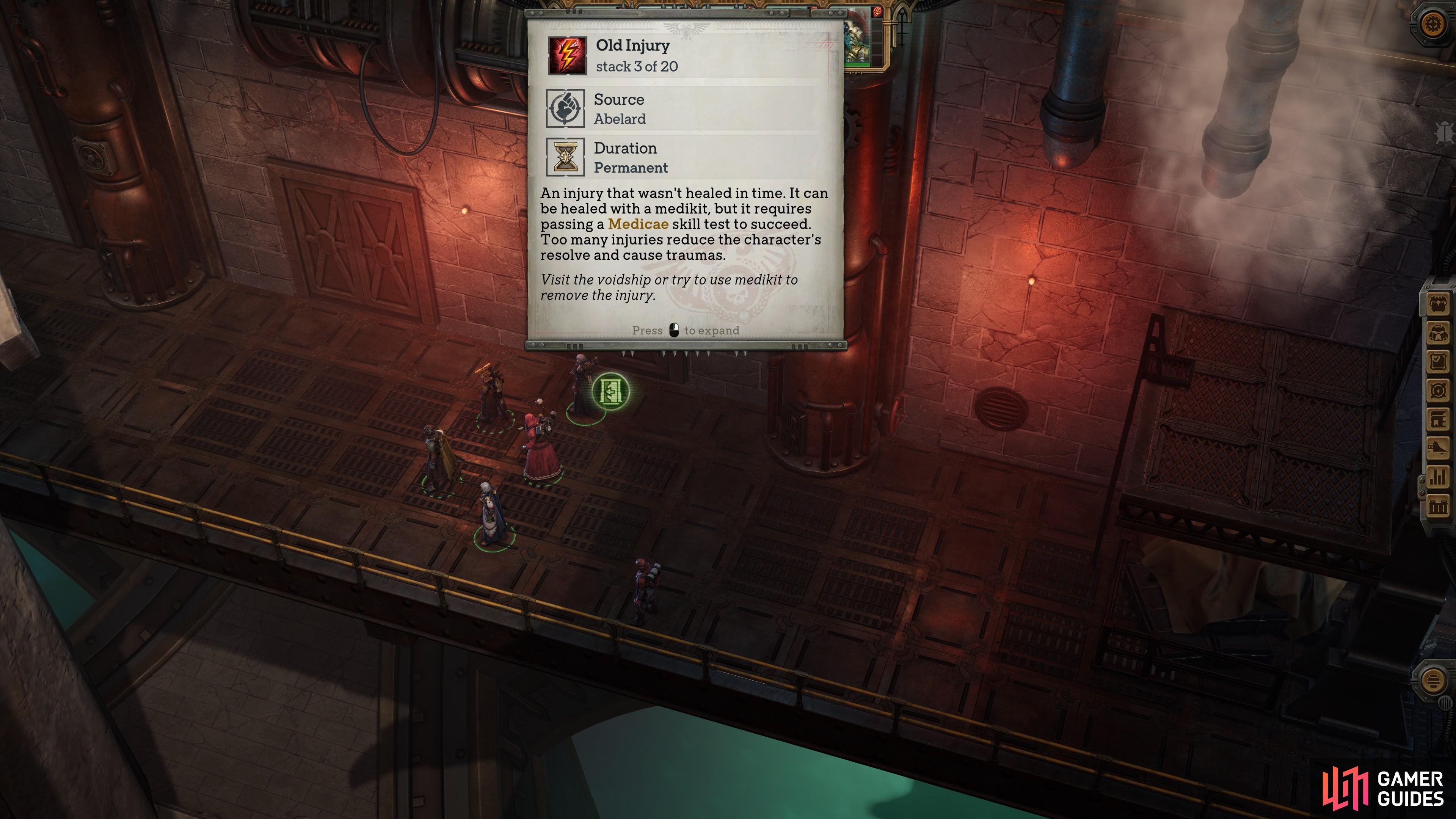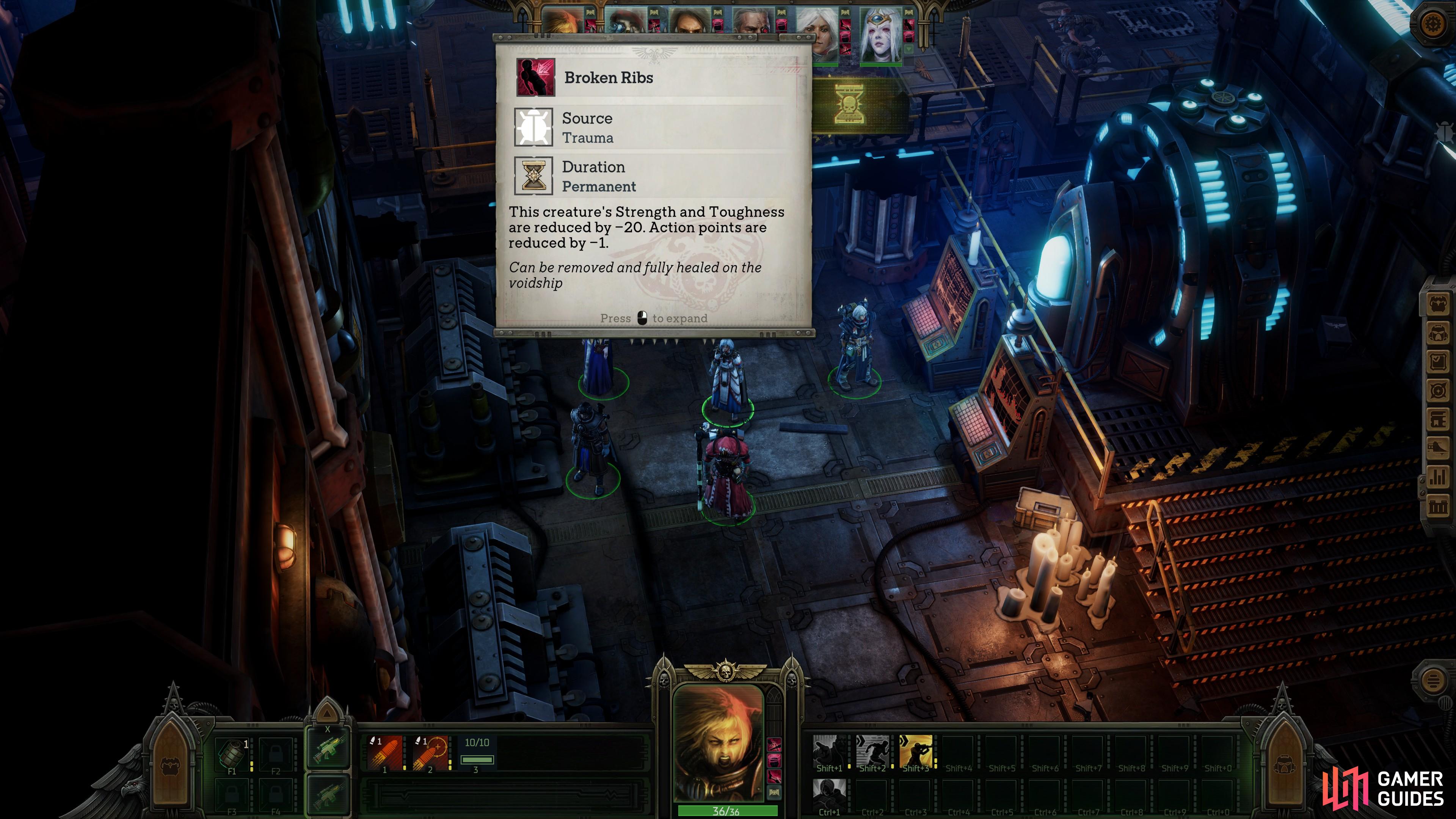As you take damage in Rogue Trader, you’ll lose Hit Points… or in Warhammer 40,000 parlance, you’ll lose Wounds. When a character reaches 0 Wounds they’ll be incapacitated and incapable of fighting until combat is resolved, at which point every character recovers to full Wounds. It’s an oddly generous system, especially considering there are no Short Rests or Long Rests to juggle, no need to manage your health between fights, and no spells or abilities with cooldowns to conserve. In most cases, you’re going into combat at full strength, except for one factor - Injuries and Traumas. This page will explain Injuries and Trauma in Rogue Trader, including how Injuries are sustained, what the differences are between Fresh Injuries and Old Injuries, how Injuries turn into Traumas, and how to cure both Injuries and Traumas.
What Are Injuries in Rogue Trader?¶
Since you automatically recover all lost Wounds when combat ends, one may be lulled into thinking that sustaining damage doesn’t matter. However, if you lose a certain percentage of your maximum Wounds in a single combat round, you’ll sustain an Injury at the end of combat. Losing Temporary Wounds doesn’t count against you when it comes to determining whether a character sustains an Injury, and if a character reaches 0 Wounds they will sustain a Trauma regardless of how many Wounds they lost in a single turn. The amount of Wounds you need to lose in a single round before sustaining an injury varies depending on difficulty, as follows:
| Difficulty | % Wounds/Round to Injure |
|---|---|
| Story | 70% |
| Normal | 60% |
| Daring | 50% |
| Hard | 40% |
| Unfair | 30% |
In addition to gaining Injuries by losing a substantial number of Wounds in a single combat round, you can also automatically accrue Injuries by being damaged by traps out of combat. On their own, Injuries aren’t too worrisome, although they do lower the Resolve of the afflicted character by 1 (the number of Injuries doesn’t seem to matter - any Injuries will lower the afflicted character’s Resolve), making them a way to reflect long-term battle fatigue. Injuries also don’t accrue until after combat ends (assuming they were gained during combat - if a character was Injured another way, they’ll gain an Injury immediately). As soon as an Injury is afflicted it’ll be a Fresh Injury, but if enough time passes it’ll become an Old Injury, which will be discussed below. While Injuries themselves won’t hinder you much, if you accrue enough of them they’ll be converted into a Trauma, which is much more debilitating. Traumas will also be discussed below.
Fresh Injuries will turn into Old Injuries after a number of turns have passed.
The Difference Between Fresh Injuries and Old Injuries¶
As soon as an Injury is sustained, it’ll be a Fresh Injury, but after several rounds (one round = six seconds if not in combat), a Fresh Injury will turn into an Old Injury. The difference? Fresh Injuries are much easier to treat. The number of rounds it takes for Fresh Injuries to turn into Old Injuries can be found below:
| Difficulty | Turns until Fresh Injuries become Old Injuries |
|---|---|
| Story | 5 (30 seconds) |
| Normal | 4 (24 seconds) |
| Daring | 3 (18 seconds) |
| Hard | 2 (12 seconds) |
| Unfair | 1 (6 seconds) |
As mentioned earlier, the main difference between Fresh Injuries and Old Injuries is how you can remove them. In the former case, pretty much any form of healing will remove Fresh Injuries - even by using a Psyker’s Invigorate ability, or other such direct healing abilities. Using Medikits will also remove both Fresh Injuries and Old Injuries, but in the case of Old Injuries, one Medikit usage will only remove one Old Injury, and these Old Injuries are removed collectively, and only when a sufficient number of Medikits are used to clear all the Old Injuries. For example, if you sustain three Old Injuries, you will need to use Medikits three times to clear them, and you’ll go from three Old Injuries to zero. So if you use a Medikit to remove Old Injuries and it looks like nothing happened… well, you need to use Medikits more to remove all the Old Injuries at once.
As a general rule of thumb, watch your character icons immediately after a fight ends to check for Injury icons. If you can catch them while they’re Fresh, you can potentially save yourself from having to use Medikits by healing quickly! In any event, catching Injuries when they’re Fresh Injuries and dealing with them before they become Old Injuries is better than risking a Trauma.
Accumulate enough Old Injuries and they’ll be replaced by a Trauma - a significant debuff that’s hard to remove on the field.
Traumas - Effects and How to Cure Them¶
Once you sustain enough Old Injuries, the stack will be replaced by a single Trauma. Also, if your Wounds are reduced to 0 in combat you’ll suffer a Trauma automatically. Traumas are far more severe than Injuries, directly debilitating the afflicted in various ways, depending on the exact Trauma inflicted. The number of Injuries it takes to result in a Trauma varies by difficulty, as follows:
| Difficulty | Number of Injuries to cause Trauma |
|---|---|
| Story | 5 |
| Normal | 4 |
| Daring | 3 |
| Hard | 2 |
| Unfair | 2 |
Below you’ll find listed some of the Traumas we’ve encountered:
| Trauma | Effects |
|---|---|
| Broken Ribs | This creature’s Strength and Toughness are reduced by -20. Action Points are reduced by -1. |
| Crippled Arm | This creature’s Weapon Skill and Ballistic Skill are reduced by -20. |
| Crippled Leg | This creature’s Agility is reduced by -20. Movement points are reduced by half. |
| Head Trauma | This creature’s Intelligence, Perception, Willpower, and Fellowship are reduced by -15. |
As you can see, Traumas are quite nasty, and in a word, debilitating. Trying to continue exploring while afflicted with a Trauma is undesirable, to say the least, and more likely than not foolhardy. Unfortunately, Traumas are also much more difficult to remove than Injuries, and cannot be resolved while on the field. Only returning to your Voidship or entering a “safe” location will provide the afflicted sufficient opportunity to convalesce. In the case of your Voidship, simply returning to the bridge should suffice to remedy any Injuries and Traumas.



 Sign up
Sign up
No Comments